Samsung Galaxy Note5 vs LG G4
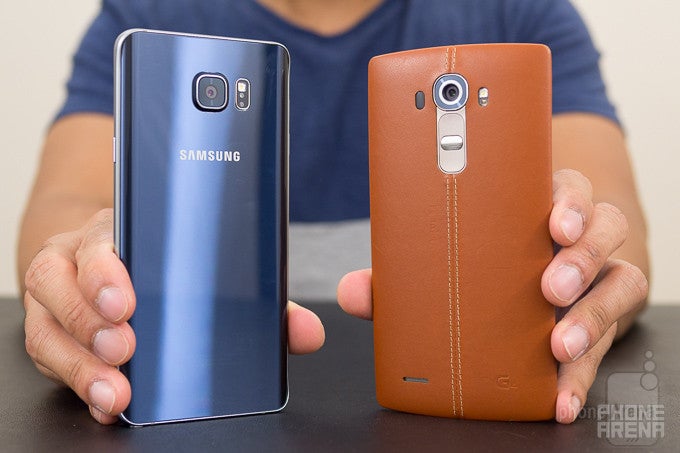
Introduction
Last year, the Samsung Galaxy Note 4 managed to receive universal acclaim for its muscular specs sheet and rich feature set. Months before it, the LG G3 caught technological enthusiasts' attention for having the first Quad-HD resolution display on a mobile device. It's only fair to say that both the Galaxy Note5 and the LG G4 arrived with high expectations, tasked with continuing the strong momentum ignited by their predecessors. This only serves to make the direct comparison between them even more interesting, for both are high-end phablets that are unique in their own special ways, and also showcase how differently the two Korean arch-rivals approach their craft. This will be interesting, so let's have a look now, shall we!
Design
The phablets that show Samsung's and LG's sophisticated understandings for “premium”.
Samsung and LG seemingly have a wildly different understanding of "premium", for the Galaxy Note5 and LG G4 are nothing alike. Samsung opted to study the design patterns of its closest competitor, Apple, and follow the prevailing industry tendency of hi-end smartphones being built out of metal and glass. The result is the Galaxy Note5, a prime example of modern day industrial design with its sleek aluminum lines and glassy sheen. To execute its revamped design vision, Samsung needed to shelve the removable battery and microSD slot, deeming them inessential for the type of customer looking after hi-end smartphones.
The LG G4 is the complete opposite. It puts the "warm, organic touch of leather" against the cold, hard industrial look of present-day flagship smartphones, making for a completely different feel for build quality and design philosophy. This rings true even if you remove the leather from the equation and take a look at the "plain plastic" LG G4 flavor. Without the leather back representing LG's fashion-rooted understanding for luxury, the LG G4 is pure utility, right down to the presence of a removable battery and microSD card slot. Placing it next to the perfectly chiseled cyborg that is the Galaxy Note5 results in a full-blown clash of aesthetics — it's the old versus new, the finely aged versus the modern, the hand-sewn versus the machine-milled.
Truth be told,both phablets have their unique virtues in the design department, and choosing between them is a question of taste, with some practical issues mixed in — can you live without a removable battery and microSD slot? Do you need a stylus, or an IR blaster? Samsung happily omitted the removable battery, microSD slot, and IR blaster from the Note5, citing lack of popular demand, but the LG G4 has all of that - except the S-Pen. Oh, and can you handle the LG G4's back-positioned power and volume keys? Truth be told, you should be able to, but everyone has their preference!
Dimensions-wise, the Samsung Galaxy Note 5 measures a bigger 6.03 x 3.00 x 0.30in (153.2 x 76.1 x 7.6 mm) than the already big LG G4, which stands at 5.86 x 3.00 x 0.39in (148.9 x 76.1 x 9.8 mm). Same goes for weight, as the LG G4 is 5.47 oz (155 g), whereas the Note5 is a beefier 6.03 oz (171 g).
All in all, facing a choice between the Galaxy Note5 and the LG G4, two polar opposites, could tell one a lot about their design tastes. There's no winner here, as the "battle" is merely a question of preferences and needs. If you like a modern, metal and glass aesthetic, and don't mind the lack of removable battery and microSD card, go for the Note5. Otherwise, you can go for something different and more practical with the LG G4.
Display
A Super-AMOLED vs IPS LCD fight for the “which has the nicest colors” award.
Once again, we're comparing two entirely different beasts. The Samsung Galaxy Note 5 has a 5.7-inch Super AMOLED display, while the LG G4 uses a 5.5-inch IPS LCD panel. They boast the same Quad-HD screen resolution of 1440x2560 pixels, which means both are exceptionally sharp with their high pixel densities (at 518ppi for the Note 5 and 538ppi for the LG G4, respectively) but their properties are still very different.
Right off the bat, we could sense that there's something imbalanced about the LG G4's color reproduction when we placed it next to the Galaxy Note5. That's because the LG G4 has a color temperature of 8031 kelvins, whereas the Note5 boasts a 6722 K color temp, which is much closer to the reference value of 6500 kelvins. This is the point where the mix of red and blue can be considered in balanced proportions. And due to being off that mark, the LG G4 inevitably appears colder, blue-ish.
In terms of brightness levels, the displays are on even ground, but the Galaxy Note5 has a small edge (pun not intended) over the LG G4, as the former goes up to 470 nits maximum brightness, while the latter goes up to 454 nits. Both screens go to 2 nits minimum, which is excellent for bedtime viewing.
Gamma response is another metric that we consider essential for assessing displays. With an average gamma value of 2.09, the Note5's display portrays lighter shades of grey as brighter than they appear in reality, which makes for a sought-after contrast boost, a characteristic of recent Samsung displays. It makes for a livelier, more dynamic screen, at the expense of a slight loss of detail in color highlights. Looking at the LG G4's measurements, its gamma value of 2.24 is actually pretty close to the 2.2 reference, which is always good to have.
Finally, the Delta E rgbcmy and grayscale average values, which we use to estimate color error, give off a good impression about a display's color balance. The Galaxy Note5's screen has a fairly even color balance, at values of 1.32 and 1.94, respectively, and no overly intense exhibiting of the primary colors, save for a tolerable bump in their brighter nuances. At 4.36 (rgbcmy) and 7.28 (grayscale), Delta E color error is significantly greater in the LG G4's display, which is mostly due to under-represented red component. The brighter the image, the more red disappears to blue and green's advantage. This compromises color balance and results in a blue-green color tint.
With everything taken into account, the Galaxy Note5's bigger, brighter, and more color-accurate Super AMOLED screen makes for a clear win over the LG G4's tolerable, but problematic IPS LCD panel.
Interface and Functionality
They are Android Lollipop smartphones every inch of the way, but the Note5 is the one where multitasking feels complete.
Both the Note5 and the LG G4 are Android Lollipop smartphones every inch of the way, and even though their functionality overlaps to an extent, the user experience is different in each. The first three Note phablets made the product line notorious for feature overload, bearing an abundance of functionality — not a bad thing by itself, but a significant portion of it came off as redundant and, well gimmicky. The Note 4 was the first to minimize the problem, and the Note5 continues the approach of slimming things down and preventing gimmicks from whisking focus away from relevant features.
Meanwhile, LG had its own problems to deal with, which is how the LG G3 came to showcase a much welcome graphical and feature overhaul of what used to be an overly cartoony interface in need of some organizing. Likewise, its successor continues in the same direction.
When we're talking about the Note5's relevant features, we can't possibly miss the S-Pen functionality, which makes Note devices stand out from the rest of the big-screen pack. For the Note5, Samsung came up with an auto-eject mechanism, writing stuff with the screen turned off, calling the Air Command from everywhere, writing in PDF files, and screen-grabbing a web page from top to bottom.
Otherwise, the Note5 feels very much like the Galaxy S6, that is very modern and reasonably easy to get around. Much of the same can be said about the LG G4, which is also an outcome of a wide-scale clean-up and graphics overhaul campaign, which began with the LG G3. LG went from having a cartoony looking UI to one that was significantly flatter and more straightforward.
The LG G4 is about as easy to get into, but also bears many of the core LG experience features. We're talking stuff like Knock On to turn the screen on and off with a double tap; QSlide apps that appear over whatever we’re doing in the moment; and Dual Window for true multi-tasking with apps that run side-by-side. With this into account, the LG G4 obviously aims towards the common user while throwing in some extra productivity features in the package, whereas the Note5 does the opposite, catering to power users first and casual users second.
Aesthetics-wise, both Samsung's TouchWiz and LG's UX 4.0 user interfaces employ bright colors and neatly ordered menus. Both are susceptible to heavy theming and offer enough in terms of customization and interactivity to satisfy most users. Homescreens are relatively easy to edit and can be expanded with widgets that serve you information, such as the weather conditions, or your system storage status.
In resume, the major difference between the Note5 and the LG G4 is the presence of S-Pen functionality, Samsung Knox, and Samsung Pay in the former. LG does have a stylus-equipped device under its helm, but is yet to offer a security platform or mobile payment system to fully match Samsung's feature set.
Processor and Memory
The Galaxy Note5's spec sheet makes the LG G4 look like a lower class device on paper, but things are a little different in reality.
In terms of technological advantage, it's pretty clear that the Galaxy Note5 is a more advanced device over LG's flagship, as Samsung's hero phablet is powered by an upper-class chipset (the 14nm octa-core Exynos 7420 vs the 20nm hexa-core Snapdragon 808), has more and faster memory (4GB LPDDR4 RAM vs 3GB LPDDR3 RAM), and is blessed with blazing-fast UFS 2.0 flash storage, whereas the LG G4 uses the familiar eMMC technology.
In benchmarks, the Note5's cutting-edge specs predictably result in better performance against the LG G4's more modest hardware grocery list, although Samsung's sheer technological advantage does not fully translate in terms of real-world performance. The Note5's memory reading and writing speeds are outrageous compared to the LG G4's, but opening apps and navigating the device, while appreciably faster, isn't an order of magnitude faster. That aside, the Note5's all-around faster chipset contributes to significantly better performance in gaming tests, taking a comfortable lead over the LG G4, whose gaming performance is actually closer to last year's Galaxy Note 4. This is simply due to the fact that the Note5's Mali-T760 MP8 GPU is a costlier, more elaborate solution than the LG G4's Adreno 418 unit.
That said, barring the occasional stutter, the LG G4 runs just as smoothly as the Note5 does in all but the most demanding usage scenarios. Still, thanks to its wider feature set, complemented by a faster chipset and a generous amount of RAM, the Note5 is the phablet that will let you do more and do it quicker. But if you would like to rely on expandable storage and a removable battery, the LG G4 is better tailored to your needs.
The internal storage options for the Galaxy Note5 and LG G4 are as follows — 32GB and 64GB for the Samsung phablet, and 32GB only for LG's. In this case, users that need to go beyond 64GB of storage for their data and don't want to rely on cloud services would be better served by the LG G4, which will take the biggest microSD card you can pop in it.
Internet and Connectivity
You won't be missing out on any essential (and inessential) connectivity with these phablets.
On the connectivity side of things, the Galaxy Note5 supports 4G LTE with a staggering amount of bands and peak downlink speeds of up to 620Mbps. It's also got MIMO (2x2) antennas for improved reception and dual-channel Wi-Fi, as well as NFC, Bluetooth 4.2 with support for the low-energy profile, and positioning via GPS, Glonass, and the Beidou systems.
But, being a Qualcomm-powered smartphone, the LG G4 is even more future-proof, as it features an integrated X10 LTE radio in addition to a GPS with Glonass, Bluetooth 4.1 BLE, dual-band 802.11 a/b/g/n/ac Wi-Fi, NFC, DLNA, 4K SlimPort support, and an IR blaster. The latter works in conjunction with the QuickRemote app, allowing us to program the phone to act as a universal remote.
Web browsing is smooth and accomplished on both smartphones, thanks to their large displays and fast chipsets. The Note5 has an edge, though, as it features a slightly larger screen, and the S-Pen has the unique ability of mimicking the function of a cursor as it hovers over the display.
Camera
Despite the Note5 being a great cameraphone, the LG G4 has some unsuspected advantages over it.
We can give you our opinion straight away - both the Note5 and the LG G4 are very competent cameraphones. One reason for this is their high-quality camera components and software algorithms. The Samsung Galaxy Note5 features a 16-megapixel main camera with optical image stabilization (OIS), and a 5-megapixel selfie shooter up front. The LG G4 stands up to it with a 16MP camera of similar rank, but one-ups the Note5 with an 8-megapixel selfie snapper. LG'srear cam has some unique spices and flavors of its own, such as laser-assisted autofocus and a dedicated color spectrum sensor for reproducing natural colors. Overall, this is shaping up to be a very interesting fight, so let's get to it!
First off, both smartphones boast elaborate camera apps that contain both very usable automatic shooting modes, as well as fully featured manual modes that let knowledgeable (or adventurous) users take full advantage of their camera sensors' potential.
In typical daylight shooting conditions, the Note5 accomplishes an evenly exposed image, but also goes for a warmer white balance 99% of the time. This imparts a slight yellow tint across the scene and results in unrealistic colors, which can be easily seen by observing the pavement in our downtown camera samples — the roads look yellow and green, rather than the gray that should be. Similarly, building facades in the same set of photos appear somewhat yellowish, due to the way white balance is handled by the Note5. Comparatively, the LG G4's camera pulls off rather natural colors that represent the actual scene to a more realistic extent. This likely owes to the color spectrum sensor working its technological magic. Exposure is similarly even, but there is another round of image quality differences between the phablets to consider.
The Galaxy Note5 aims for a punchy, in-your-face type of photo, which is accomplished with a slight contrast bump. In addition, the Note5's auto mode applies ostensible sharpening to the scene. The LG G4, though, does things a bit differently. Rather than appearing exaggerated, its photos tend to look softer, but with preserved fine details. In fact, on most occasions, the G4 manages to do just a little bit better than the Note5 in the details department, along with delivering a slightly better overall scene exposure. When taking photos with the LG G4, however, do remember to keep a steady hand, as it seems to be a bit easier to come up with a blurred photo with the G4, in comparison to the Note5.
In resume, the Note5 goes for warm-toned, punchy tones with a crisper look, while the LG G4 is all about keeping it real with its natural color reproduction and fine detail preservation. For example, very small texts in the background usually appear a tad more legible on the G4's shots, whereas the Note5 can smash them with its aggressive sharpening and contrast at times. Or, in another example, taking a look at the traffic lights in our downtown shots, the LG G4 is able to capture the mini LEDs that comprise the signal light itself, whereas the Note5 pretty much renders a solid color.
Moving on, the way the two phablets handle themselves in HDR mode is interesting by itself. The Galaxy Note5 actually drops the warm white balance in favor of a more natural one, and does its best to illuminate all visible objects as much as reasonably possible. The LG G4, on the other hand, retains the natural color balance that it always seems to strive for, but goes for a somewhat hazier and not as consistent overall picture. All in all, the two handsets perform very similarly in the HDR contest, but the Note5's photos tend to stand out a bit more.
Low light photography is also important for judging a camera's qualities. In low light, the LG G4 doesn't always keep those natural colors we've been praising. Outdoors, the presence of multiple artificial light sources tends to confuse it into throwing a bit too much yellow in the color mix for some reason, which may give photos a yellowish tint and turn streetlights into glowing halos. The Note5 has no such issues, able to handle different light sources reasonably well, and fare quite favorably with the automatic white balance and exposure setting. That aside, both phablets take similarly clear and impressive photos. However, do consider that fine details are slightly more defined in photos taken with the LG flagship, and the image appears less noisy. Moreover, some of the shots we took make it evident that the LG G4 can produce more natural colors in night-time photos, given the absence of strong artificial light sources in the scene to confuse the camera sensor.
Indoor shots are handled pretty similarly by both devices. When strong or medium lighting is present, both handsets deliver largely identical photos, with the G4 having a bit of an advantage in the way of fine details and color saturation. Low light shots look largely the same, but engaging the LED flash on both makes for a significant difference. The LG G4's dual-tone LED flash might leave you disappointed, as it accomplishes about as much as the LG G3's from last year. That is, scenes lit with it appear greenish and colors look off. The Note5's flash lights up the objects with a comparatively neutral tone, and although colors appear a little pale, they certainly look more realistic.
On the side of front camera performance, the Note5 takes some good looking selfies, as long as there’s an abundance of lighting around. Not only do we have a wide-angled lens capable of capturing a group of people into the shot, but it’s accompanied with some editing tools that offer real-time adjustment. However, we find them to be way to artificial, going as far as transforming us into anime characters.
The LG G4's front-facing 8-megapixel camera captures great-looking selfies, and its wide-angle lens ensures that you’ll get more than your face filling up the shot, so friends can join in without being cut out. However, just know that the best results occur when strong lighting is evenly present in the scenery. Under less light, details become a bit smeary.
When it comes down to video quality, the Note5 provides a wealth of resolutions to capture video. Specifically, we have 3840 x 2160 UHD, 2560 x 1440 QHD, 1080p 60fps, 1080p 30fps, 720p, and VGA. Between the various shooting modes, the only major difference is detail. The LG G4’s video recorder is also armed with UHD, Full-HD, HD, and Slo-mo modes.
Comparing videos shot in 1080p resolution at 30 frames per second between the two, detail is pretty good with both, but the Note5 looks ever so slightly cleaner. Same goes for its digital zoom feature, which looks a bit clearer up-close. Image stabilization works great in both devices, but when it comes down to sound, the Note5 takes the lead as well, with voices appearing nice and full, while the LG G4's mic picks them up as rather weak and thin in comparison.
Boosting the resolution up to 4K, image quality is, again, very good in both phablets, but we couldn't help but be more impressed by the Note5's outstanding, sharp detail. On the other hand, the LG G4's colors are a bit sweeter, in a good and natural way.
Multimedia
Multimedia is what phablets do best, so you won't be disappointed in either.
It has to be noted that the Note5’s audio output is less than its predecessor's, at 70.7dB. While that’s still loud enough to have a commanding presence in small rooms, there’s a hint of sharpness when it’s set to the highest volume setting. The LG G4, though, offers a maximum output of 79 dB, which feels borderline deafening, but is also a couple notches below the figure of the G3. Naturally, there’s plenty of volume to let music travel far in small and larger spaces, but the sound feels pretty flat, unless we adjust the equalizer settings.
When it comes to video watching, we have no qualms whatsoever with the Note5’s experience. Superb pretty much sums it up, as its display is ideal for all sorts of content consumption. Of course, setting the big 5.7-inch display to ‘adaptive’ mode accentuates the experience by adjusting the contrast and color saturation for the most optimal viewing pleasure. Meanwhile, the LG G4's 5.5-inch quad-HD IPS Quantum Display gets its true potency to come through by watching videos on it. They come to life, thanks to the wisely adjusted colors and the handset's smooth operation.
Both phablets excel at multimedia, but we'd recommend the Galaxy Note5 for video lovers because of the ability to choose between different screen modes and select the one your eyes like best. On the LG G4, you're stuck with what LG has given you — a decent, but not great display. Music fans, on the other hand, will be happy with either of the two devices, but if you plan on taking more than, say, 50GB of downloaded music and other things with you outside, you'll have to go for the LG G4 and its expandable storage. There's only so much content you can load on a 32GB or 64GB Note5 that's unable to take a microSD card.
Call quality
Both devices make the cut, unless you are very picky.
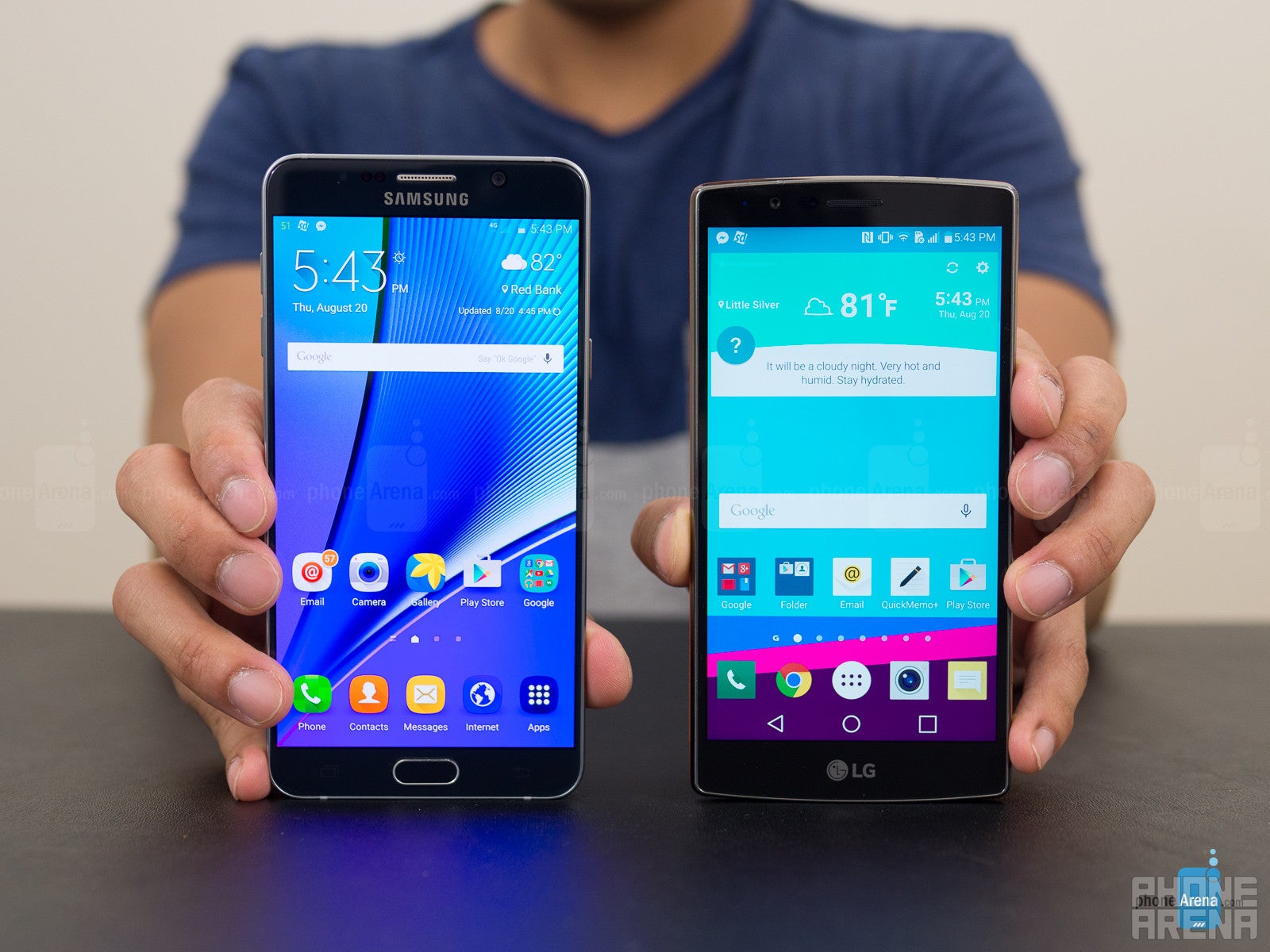
On the LG G4's side, the phone gets the job done, as the earpiece and speakerphone produce strong volume to make them useable in noisy environments. However, there’s a slight hint of distortion to voices through the earpiece that make them sound a little bit artificial, nothing too terrible. On the other end of the line, things seem to flow better, since voices sound great.
Battery
Two phablets, two 3000mAh batteries, and a clear win for the Galaxy Note5.
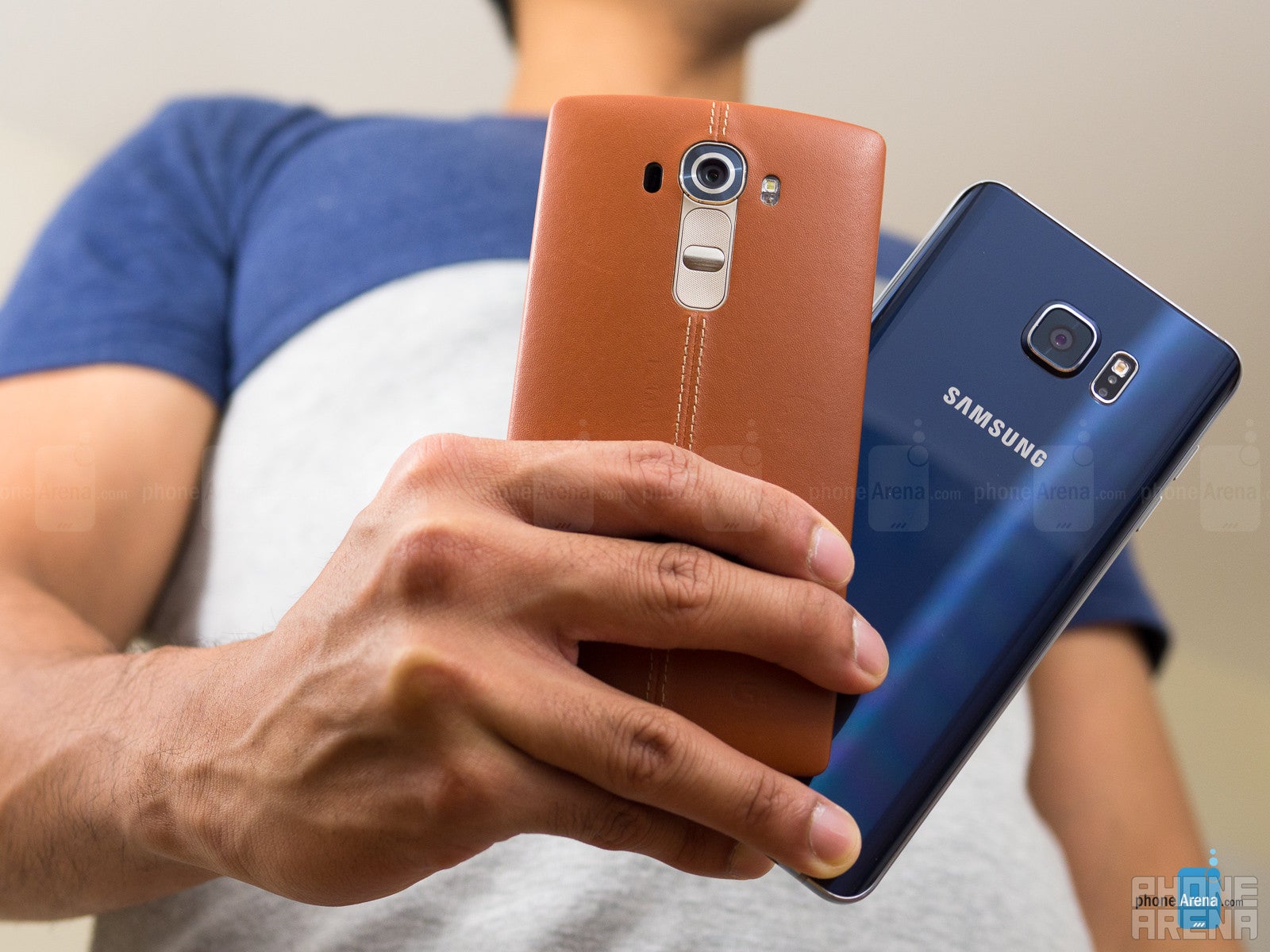
Moreover, the Note5 offers one of the fastest battery recharge times around. It needs only 81 minutes to fill up using the bundled charger. The Note5 also features built-in wireless charging, something that the LG G4 lacks out of the box. Although the handset does support wireless charging, the bundled charger doesn't use the technology, and charging the LG G4 out of the box takes 127 minutes.
Conclusion
Both the Galaxy Note5 and the LG G4 are superb devices and you can't go wrong with either. But, save for the lack of removable battery and microSD card storage, our hearts and brains go for the Note5, out of pure technological enthusiasm. But, save for the Note5's arguably better display and significantly faster gaming performance, the rest is up for anyone to decide.
Technologically, the Note5 is the more advanced device. Its Super AMOLED display is superior to LG's IPS LCD technology in the essential category of color balance, even if the shifts in color reproduction under extreme viewing angles are something to be wary of. Moreover, the Note5's processing and graphics performance tackle the LG G4's to the ground, by virtue of the higher class silicon and extremely fast flash storage used. And even though the phablet has more power on tap, the Note5's battery lasts significantly longer than the LG G4's.
Then again, it has to be acknowledged that the LG G4, despite being LG's flagship smartphone, is currently much cheaper than the Samsung Galaxy Note5, making it more accessible to those interested in a phablet. After all, not everyone is looking after the best graphical performance or the elaborate set of S-Pen features. To those looking for a solid hi-end phablet that doesn't break the bank, the LG G4's a godsend. It has enough all-around technological prowess and design charm to satisfy the overwhelming majority of users, not to mention a killer camera setup that rivals, and at times even surpasses, that of the Samsung.
All things considered, for most users, deciding between the Galaxy Note5 and the LG G4 would be a classic decision of either splurging on a device that's more expensive and able to do more than they actually need, or paying less for a device that seems to be less pretentious, but about as versatile in almost all cases. Whether the Note5 is worth the price premium is up to your individual tastes, needs, and financial situation, which is why we can't straight up recommend it as a better purchase than the LG G4. But if pure technological enthusiasm, or the need for stylus-driven mobile productivity are the motivating forces in your decision-making process, you will end up happier with the Note5.
Samsung Galaxy Note5
Pros
- Modern look and build
- Powerful S-Pen functionality
- Longer battery life
- Faster chipset
LG G4
Pros
- Original design language
- Expandable storage and removable battery
- Marginally better camera

Follow us on Google News

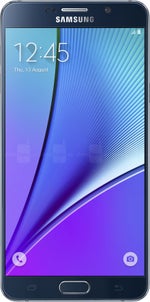
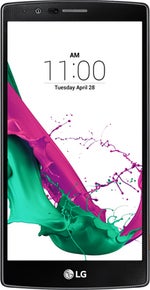

















![A new Android bug is making it impossible to install new apps. Are you affected? [UPDATE]](https://m-cdn.phonearena.com/images/article/176703-wide-two_350/A-new-Android-bug-is-making-it-impossible-to-install-new-apps.-Are-you-affected-UPDATE.webp)

Things that are NOT allowed:
To help keep our community safe and free from spam, we apply temporary limits to newly created accounts: